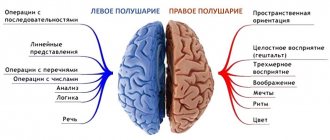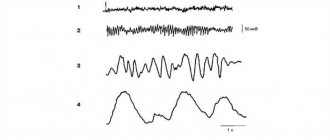Plegia and paresis are different stages of the same disease. Plegia (paralysis) involves a complete lack of movement, and with paresis the patient has partial impairments or slightly reduced activity. Paralysis can develop in the lower and upper limbs.
As a rule, plegia and paresis are symptoms of severe neurological disorders, the level of development of which is determined by the degree of development of muscle paralysis. Various muscles may be at risk (smooth muscles of the stomach, extraocular muscles, etc.).
This is weakness of some muscles caused by a disruption in communication with the nervous system and disorders of brain activity. Another cause of pathology is dysfunction of peripheral nerves, which lose the ability to transmit brain impulses to muscles.
Classification of violation
According to the number of limbs affected, experts divide paralysis into several categories:
Disorders are also classified according to the level of motor neuron damage. When the peripheral motor neuron is damaged, the disease is called flaccid (peripheral) paralysis; when the corticospinal tract is damaged, it is called spastic or central.
Classification
Experts distinguish several types of plegia:
- monoplegia, occurs when one limb is affected;
- paraplegia, symmetrical limbs are affected, can occur with damage to the upper or lower limbs;
- triplegia, 3 limbs are involved in the process;
- tetraplegia, all limbs are affected;
- hemiplegia, impaired motor activity on one side of the body;
- myoplegia occurs as a family disease, when the syndrome manifests itself in several family members.
According to the location of pathological changes, plegia is central, peripheral and extrapyramidal.
Central plegia is characterized by increased muscle tone, reflexes, severe muscle spasms, and frequent friendly movements.
In accordance with the strength of muscle spasticity, it is customary to divide plegia into flaccid, rigid and spastic.
Kinds:
- By origin, organic and functional plegia are distinguished.
- By localization - central and peripheral.
- By location - right-handed, left-handed.
- According to the course - acute (diaschisal), chronic (progressive), regressive (tending to improve).
Causes and forms of development of deviations
Plegia cannot appear on its own; its development requires a trigger mechanism, that is, pathological processes, including:
- bulbar palsy - can have a progressive or acute form, affecting the muscles of the larynx and tongue;
- Bell's palsy - damages the face;
- familial myoplegia - can occur simultaneously in several relatives.
The development of the syndrome is also observed against the background of damage to the shoulder joint and can occur when the baby moves incorrectly along the birth canal.
Any paresis, like plegia, is associated with disorders of the nervous system, depending on the degree of its development, the level of complexity of the pathology will depend.
If the damage has spread to the roots, anterior horns and peripheral vessels, this causes loss of reflex and voluntary activity. This also affects tendon mobility.
With flaccid paresis, there are no protective reflexes or synkinesis; due to disorders in the functioning of the nerves, the muscle group that ensures their functioning atrophies.
Symmetrical paresis of the legs or feet can develop due to polyneuritis; if the plexuses are disturbed, unilateral plegia, localized in the muscles of the pelvic girdle, is caused.
Complete paralysis occurs with complete damage, when not only one segment of the brain space is affected, but also adjacent ones. The development of such a disease is possible in severe illness (amyotrophic lateral sclerosis, poliomyelitis).
Bell's palsy is caused by malignant tumors, infections, damage or hypothermia of the brainstem area, unsuccessful injury or surgery.
Familial paralysis develops for unknown reasons, and the appearance of bulbar palsy extends to the medulla oblongata.
A common cause of monoplegia is damage to the cortex in the cerebral hemispheres, vascular damage, tumors, abscess and trauma. It rarely occurs in lesions of the corticospinal tract, spinal cord, or brainstem due to the close proximity of fibers to the lower and upper extremities.
Paraplegia can develop when the spinal roots, spinal cord, or peripheral nerves are affected. Sometimes leg weakness can develop with hydrocephalus and tumors of the parasagittal zone.
Subacute and chronic paraplegia can develop with spinal cord tumors, multiple sclerosis, syphilitic meningomyelitis, diseases of the musculoskeletal system, herniated intervertebral discs in the cervical region, etc.
Possible causes of tetraplegia include the same factors as paraplegia. But the disease often occurs with lesions of the spinal cord in the cervical, thoracic and lumbar regions.
Other causes of plegia include: poisoning with salts of heavy metals, alcohol and poisons;
News
Risk of cardiovascular disease in personality type D: mechanisms
The risk of cardiovascular diseases in people belonging to type D personality is associated with inattention to their own health - this is the conclusion made by scientists.
The course of amyotrophic lateral sclerosis depends on the genotype
French scientists have studied the variants of ALS, mainly observing the consequences of the TARDBP gene mutation.
Regular consumption of low-fat dairy products reduces the risk of stroke
It is possible to prevent cardiovascular diseases through proper nutrition. According to the results of a study conducted by Swedish scientists, consuming low-fat dairy products reduces the risk of cardiovascular diseases, thereby protecting a person from stroke.
Theta stimulation of the left hemisphere of the brain is effective in hemiignoring
A severe consequence of a stroke is ignoring half of space and half of the body, which can be treated with theta stimulation.
Diet rich in antioxidants may help prevent stroke
Eating foods containing antioxidants may reduce the risk of stroke, according to a recent Swedish study.
Dexpramipexole offers hope for the future for patients with amytrophic lateral sclerosis
New trials of the innovative drug dexpramipexole (KNS-760704) confirm its safety and tolerability in patients suffering from amyotrophic lateral sclerosis (ALS).
Hyperbaric oxygen therapy is effective for stress disorders in war veterans
American researchers have concluded that treatment with oxygen at elevated pressure (hyperbaric oxygen therapy) significantly improves the functioning and quality of life of war veterans.
Aspirin reduces the risk of cerebral aneurysm rupture
It is possible to reduce the risk of rupture of an intracranial aneurysm by taking aspirin, American scientists have come to this conclusion.
Turmeric helps recover from stroke
Turmeric is an important element of Indian cuisine and traditional Ayurvedic medicine. Research shows that curcumin, found in rhizomes and stems, has beneficial effects on the heart, brain and joints.
Alternative to warfarin for atrial fibrillation
The American Heart Association, one of the most authoritative medical societies on cardiovascular disease, recommended dabigatran for use in the prevention of stroke in atrial fibrillation.
People who have had a stroke and have atrial fibrillation are at greater risk of developing dementia
Among people who have had a stroke, the risk of developing dementia (dementia) is significantly higher in those who have atrial fibrillation (atrial fibrillation).
One of the causes of amyotrophic lateral sclerosis may be a retrovirus
A retrovirus that inserted itself into the human genome thousands of years ago may play a significant role in the development of neurodegenerative diseases such as amyotrophic lateral sclerosis (ALS), also known as Lou Gehrig's disease.
Stroke is getting younger
Ischemic stroke is becoming less common in older people, but more common in young people. This is evidenced by data from the American Stroke Association.
Serotonergic antidepressant improves recovery after stroke
Fluoxetine can accelerate the recovery of motor functions after an ischemic stroke, scientists from San Francisco came to these conclusions.
Symptoms of pathology
Each age category has its own manifestations of the disease. Also, the signs differ due to their appearance:
- Bell's palsy is characterized by the lack of movement of the facial muscles on one side. At the same time, the patient’s speech is incomprehensible, he cannot open his eyes freely and eat without support.
- With bulbar palsy, patients complain of severe and sharp headaches, rapid heartbeat and difficulty breathing. Patients may experience dizziness, chills or fever, lack of clarity of speech, and problems with swallowing and breathing. Eating becomes impossible as all muscles are affected.
- The symptoms of pseudobulbar plegia are similar to the previous disease, but there is no atrophy of the facial muscles with sudden contractions. Sometimes all limbs may be affected simultaneously.
Weakness of any muscle or group leads to changes in gait, foot drop when raising the leg, weakness of the arms and legs when moving, and head droop.
If any symptom appears, you should immediately contact a specialist. The possibility of effective therapy and the duration of the rehabilitation period will depend on this.
Symptoms
As a rule, the primary appearance of plegia is noticeable discomfort in the muscles when moving.
Main signs of plegia:
- lack of active movements, distorted facial expressions;
- muscle hypertonicity - resistance when trying to bend a limb (at the elbow or knee), which occurs freely after overcoming the initial resistance;
- increased reflexes in the affected area;
- decreased abdominal reflexes on the plegic side;
- decreased overall sensitivity;
- identification of reflexes of spinal automatism;
- involuntary muscle contractions during motor acts;
- pathological reflexes of Babinsky, Gordon, Oppenheim, Schaeffer, extensor reflexes of Redlich and Rossolimo, Bekhterev-Mendel, Zhukovsky, etc.
Plegia is distinguished by the location of the lesion. For example, with the bulbar form, the tongue and larynx suffer. Pseudobulbar plegia is manifested by frequent and severe headaches, tachycardia, shortness of breath, and difficulty breathing. One or all limbs may be affected. Externally, the disease is manifested by changes in gait, sagging of the foot when raising the leg, a sharp decrease in muscle strength in the arms and legs when moving, and drooping of the head.
Making a diagnosis and conducting research
Typically, otolaryngologists, psychoneurologists, psychiatrists, neurosurgeons and pulmonologists are involved in the diagnosis of plegia. When identifying the causes of the syndrome, a detailed history taking and identifying each patient’s propensity for such psychogenic reactions is important.
When collecting anamnesis, the patient must answer several questions:
- duration of decrease in muscle strength;
- approximate reasons that caused the complaints (fever, diarrhea, headache, ingestion of canned food);
- whether harmful substances are used in the work;
- Do relatives have such phenomena?
A neurological examination is also carried out with an assessment of muscle strength using 5 points and a search for other manifestations (loss of reflexes, facial asymmetry, muscle atrophy).
The patient is prescribed a blood test to determine the erythrocyte sedimentation rate and the number of leukocytes. A toxicological analysis is carried out to identify poisoning.
Additional studies include:
- electroneuromyography (to assess the electrical activity of muscles, the time of nerve impulse conduction);
- test with Proserin (to determine myasthenia gravis);
- magnetic resonance angiography (to assess the integrity and patency of arteries in the skull, detect brain tumors);
- MRI, computed tomography of the spinal cord and head to study their structure, identify tissue disorders, tumors, hemorrhages, ulcers, etc.;
- electroencephalography to assess the electrical activity of areas of the brain.
A neurosurgeon may be needed.
Approach to therapy
As a rule, the primary appearance of plegia is muscle discomfort. If the therapy is incorrectly chosen or absent, the pathology can cause complete paralysis.
Usually, with partial immobility, severe pain and acute illnesses appear, on the basis of which treatment is prescribed. Primary therapy is usually aimed at initially identifying and eliminating the underlying cause.
There are several methods for treating pathologies:
- surgery to remove a tumor of the spinal cord or brain, removal of hematomas, ulcers and antibacterial treatment;
- treatment with antibiotics for infectious damage to the nervous system;
- normalization of blood pressure , prescribing medications to improve blood flow in the brain and metabolism;
- to eliminate poisoning, vitamins A, B, C and solutions ;
- the use of drugs to improve neuromuscular reactions in myasthenia gravis;
- For botulism, antibotulinum serum .
In addition to drug therapy, massage courses are prescribed to increase muscle tone. An important role in the treatment of various types of pathology is played by the determination and willpower of the patient, who must strive for recovery to activate internal vital forces.
Treatment of plegia
Therapeutic measures are aimed primarily at treating the underlying disease.
With the help of surgical operations, tumors in the spinal cord or brain, as well as hematomas and abscesses are removed.
Antibacterial treatment helps get rid of infectious processes, symptomatic treatment helps to correct blood pressure, improve microcirculation and metabolism in tissues, and increase neuromuscular reactions in myasthenia gravis.
The main types of drugs used in the treatment of plegia:
- nootropics and neuroprotectors;
- drugs that improve microcirculation in the brain and spinal cord;
- muscle relaxants;
- cholinesterase inhibitors;
- antioxidants.
Physiotherapy (electrophoresis, kinesiotherapy, magnetic therapy), massage and exercise therapy are also actively used.
Complications and prevention
In the absence of proper treatment, complications may occur in the form of impaired labor and social adaptation, persistent neurological defect and decline in muscle activity.
Preventive measures include:
- giving up alcohol and smoking;
- timely detection and treatment of infections, contacting a doctor when symptoms appear;
- checking blood pressure;
- healthy lifestyle, walks in the fresh air, exercise, sleep at least 8 hours;
- compliance with the diet and diet, adding foods with vitamins.
You should also normalize the load after restoration of muscle functions, avoid hypothermia and the manifestation of neuroses.








